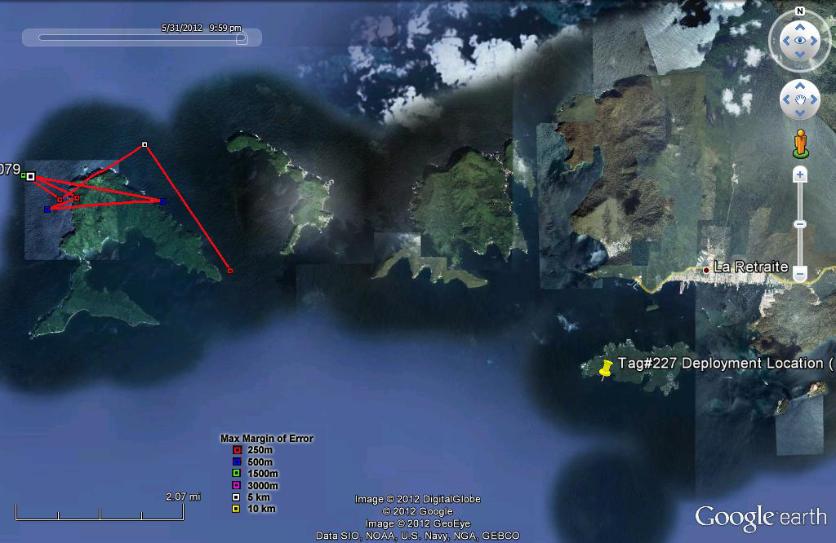During the Trini Tarpon Tournament,
5 satellite tags were deployed. These tags were supplied/sponsored by the
Bonefish & Tarpon Trust (http://www.tarbone.org/)
based in Key Largo Florida and the Division of Marine Biology and Fisheries,
Rosenstiel School of Marine and Atmospheric Science, University of Miami. The
satellite tagging program’s goal is to learn more about tarpon migrations and spawning areas in the Gulf of Mexico,
southeastern U.S. and the Caribbean Sea; Trinidad is the only place in
the Caribbean that it is being done. Basic Description
of tags: Pop-Up Archival
Transmitting (PAT) tags: The PATs, utilize satellite
technology and are relatively small computerized sampling devices attached to the
back of a tarpon via a titanium dart. A PAT contains electronic sensors that
every 10 seconds records the fish’s depth, light level, temperature and
salinity of surrounding water. PATs are pre-programmed to automatically release
from the fish at a specific date and time (usually about six to eight months
after deployment). At that moment the tags “pop-up” to the surface and transmit
compressed versions of the stored information to a network of orbiting
satellites. All the information is forwarded to the computers at the University of Miami’s tarpon conservation research
laboratory for detailed analyses. Smart Position and Temperature (SPOT) Tags: SPOT Tags are one of the most advanced technology tags used by researchers. Like the other types of tags, it records a variety of measurements, such as temperature, salinity, and depth. However, powered by a very powerful transmitter, SPOT Tags regularly send their recorded data to satellites; as opposed to PAT tags which only send their data after they ‘pop-off’. These tags are primarily designed for use on animals that are commonly found at the ocean's surface, where regular broadcast to a satellite is possible. Their data is also more accurate than PAT tags. Note on Margins of Error: When looking at the below maps, keep in mind that the location points have different margins of error. This is because the strength of the signal sent to the satellite is dependent on how long the fish surfaces for and also the location of the satellites at that point in time. It needs to make contact to 2 or 3 satellites for an accurate position. The location points are color coded to depict the point’s accuracy. |
1) PAT TAG 189 - This tag came off prematurely and was retrieved (using an ARGOS transmitter locator device provided by the University of Miami) approx 13miles west of San Fernando and 7 miles north of La Brea. There may be several reasons for the tag’s premature release:
- The fish may have been caught and killed, and the tag pulled off and tossed back into the sea.
- The tag may have become snagged in debris or mangrove and pulled out if the fish.
2) PAT TAG 190 - Someone in Trinidad found it on a beach, and sent the tag back to the University of Miami. The data showed that the tag was on fish for 3 months, and it did not move much.
3)PAT TAG 191 - This tag recently began transmitting from the Gulf of Mexico, however, the data showed that the tag was
only on the fish for a few hours, and had been drifting for the last 6 months. It is unclear why the tag did not begin transmitting when it came off the fish (as did Tag 189).
4) SPOT TAG T195 – This tag has not been heard from since Nov 13th 2011. This is odd and it is believed that the fish (and tag) may have been consumed by a predator. However, one particularly interesting observation from the fish’s movements is that the fish not only went into the Caroni swamp, but went very deep into the swamp for several days.
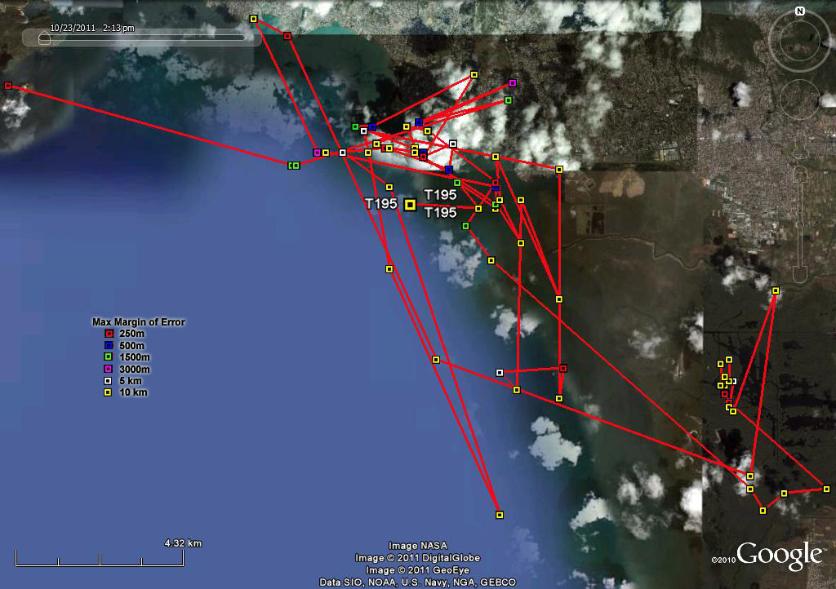
5) SPOT TAG T198 - According to the data, this fish was caught and killed by someone, and the person still has the tag. The tag is still transmitting, however, it is in a house somewhere and therefore the signal is not strong enough to get an exact location. Trying to re-aquire the tag is not a priority, since all the data has already been uploaded. The below map is of the fishes movements before it was caught and after.
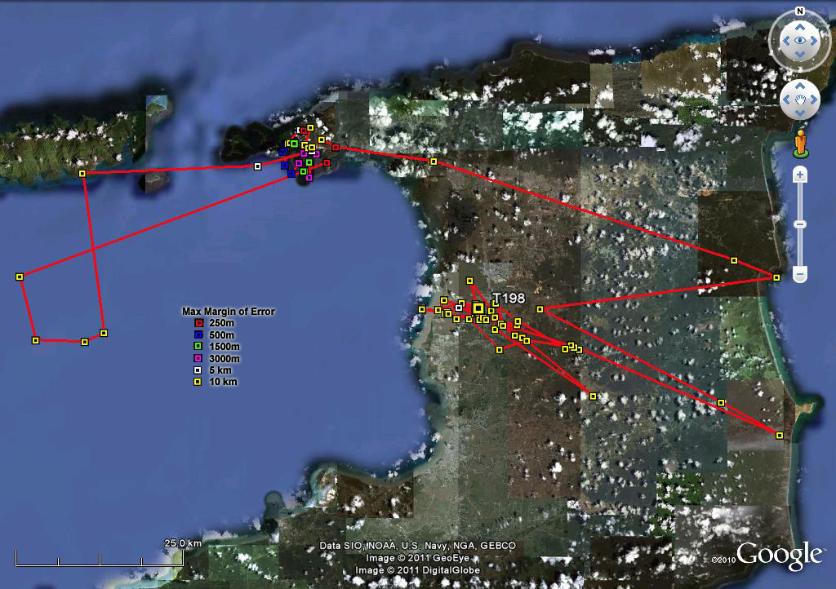
Because of the interest in Trinidad’s tarpon population and the question of if they migrate to the US, the University of Miami has sent us 2 more tags which were deployed by the Trini Tarpon Tournament organizing committee in December 2011:
PAT Tag 200 - This fish was tagged in Dec 2011, however, it was not heard from until Feb24th 2012 and has not been heard from since Feb28th 2012. One reason for this may be that the fish is on the move and typically do not surface as often when they are moving. The track displayed in the image below indicates that the fish has moved out from Trinidad.
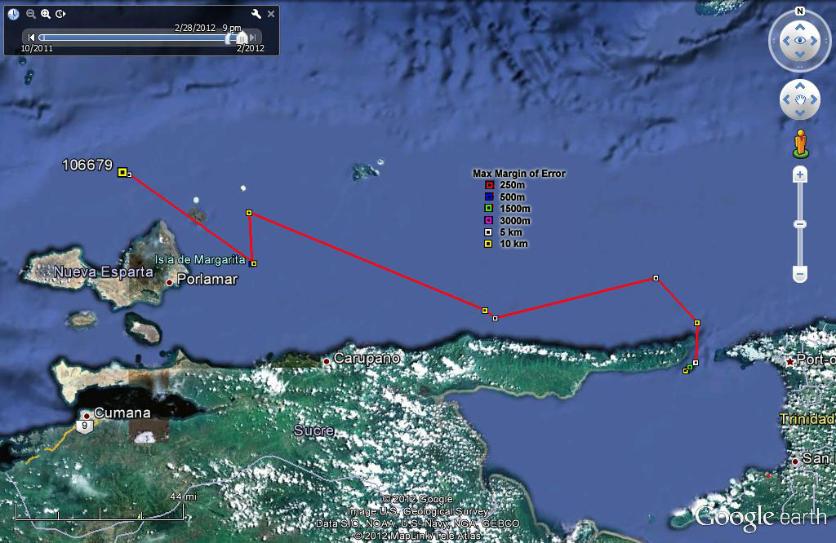
SPOT TAG 222 - This tag came off a few weeks after being tagged and the tag is still drifting in the Gulf of Mexico.
Future tagging:
Two(2) more tags were deployed by the Trini Tarpon Tournament on May 11th and May 15th 2012; Tag#197 & Tag#227. Both of the fish are doing fine and sending back regular signals! They are both still in Trinidad and have not made any migration movements as yet. Below are the maps of their movements thus far.
TAG #197 as of May 27th :
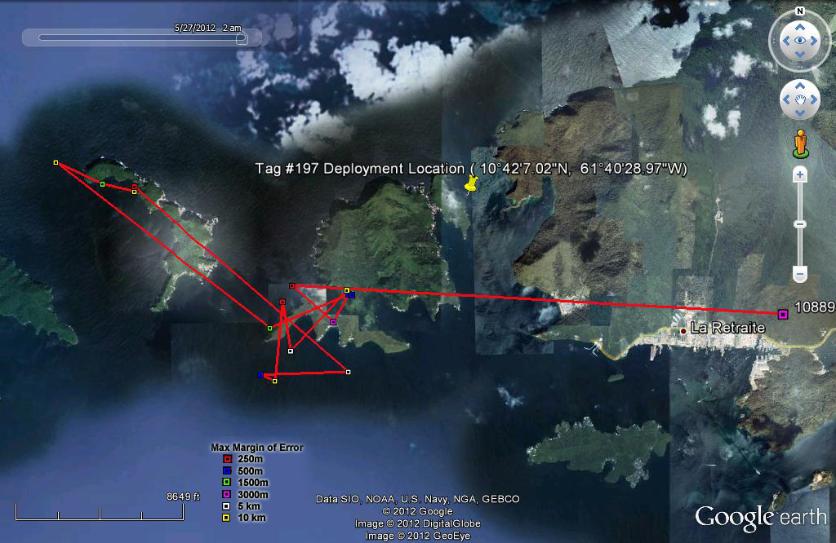
TAG #227 as of May 31st:
